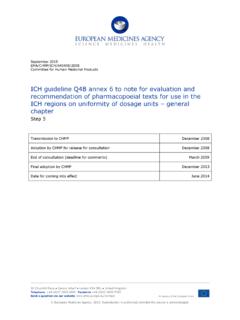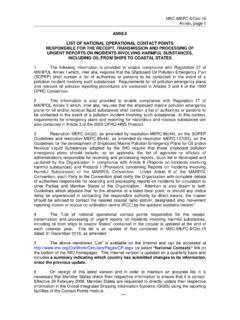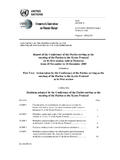Transcription of CHAPTER 6. VISUAL AIDS FOR DENOTING OBSTACLES
1 CHAPTER 6. VISUAL aids FOR DENOTING OBSTACLES . Objects to be marked a) such marking and lighting may be omitted when the and/or lighted obstacle is shielded by another fixed obstacle ;. b) the marking may be omitted when the obstacle is lighted Note. The marking and/or lighting of OBSTACLES is by medium-intensity obstacle lights, Type A, by day and intended to reduce hazards to aircraft by indicating the its height above the level of the surrounding ground presence of the OBSTACLES . It does not necessarily reduce does not exceed 150 m;. operating limitations which may be imposed by an obstacle .
2 C) the marking may be omitted when the obstacle is lighted by high-intensity obstacle lights by day; and Recommendation. A fixed obstacle that extends above a take-off climb surface within 3 000 m of the inner d) the lighting may be omitted where the obstacle is a edge of the take-off climb surface should be marked and, if the lighthouse and an aeronautical study indicates the runway is used at night, lighted, except that: lighthouse light to be sufficient. a) such marking and lighting may be omitted when the obstacle is shielded by another fixed obstacle ; Recommendation. A fixed obstacle above a horizontal surface should be marked and, if the aerodrome is used at night, lighted except that: b) the marking may be omitted when the obstacle is lighted by medium-intensity obstacle lights, Type A, by day and a) such marking and lighting may be omitted when: its height above the level of the surrounding ground does not exceed 150 m; 1) the obstacle is shielded by another fixed obstacle ; or c) the marking may be omitted when the obstacle is lighted 2) for a circuit extensively obstructed by immovable by high-intensity obstacle lights by day.
3 And objects or terrain, procedures have been established to ensure safe vertical clearance below prescribed d) the lighting may be omitted where the obstacle is a flight paths; or lighthouse and an aeronautical study indicates the lighthouse light to be sufficient. 3) an aeronautical study shows the obstacle not to be of operational significance;. Recommendation. A fixed object, other than an b) the marking may be omitted when the obstacle is lighted obstacle , adjacent to a take-off climb surface should be by medium-intensity obstacle lights, Type A, by day and marked and, if the runway is used at night, lighted if such its height above the level of the surrounding ground marking and lighting is considered necessary to ensure its does not exceed 150 m.
4 Avoidance, except that the marking may be omitted when: c) the marking may be omitted when the obstacle is lighted a) the object is lighted by medium-intensity obstacle lights, by high-intensity obstacle lights by day; and Type A, by day and its height above the level of the surrounding ground does not exceed 150 m; or d) the lighting may be omitted where the obstacle is a lighthouse and an aeronautical study indicates the lighthouse light to be sufficient. b) the object is lighted by high-intensity obstacle lights by day. A fixed object that extends above an obstacle protection surface shall be marked and, if the runway is used A fixed obstacle that extends above an approach or at night, lighted.
5 Transitional surface within 3 000 m of the inner edge of the approach surface shall be marked and, if the runway is used at Note. See for information on the obstacle protection night, lighted, except that: surface. annex 14 VOLUME I 6-1 25/11/04. annex 14 Aerodromes Volume I. > m < m > m > m < m > m White Orange or red Figure 6-1. Basic marking patterns Vehicles and other mobile objects, excluding Marking of objects aircraft, on the movement area of an aerodrome are OBSTACLES and shall be marked and, if the vehicles and aerodrome are used at night or in conditions of low visibility, lighted, except General that aircraft servicing equipment and vehicles used only on aprons may be exempt.
6 All fixed objects to be marked shall, whenever practicable, be coloured, but if this is not practicable, markers Elevated aeronautical ground lights within the or flags shall be displayed on or above them, except that movement area shall be marked so as to be conspicuous by objects that are sufficiently conspicuous by their shape, size or day. obstacle lights shall not be installed on elevated ground colour need not be otherwise marked. lights or signs in the movement area. All mobile objects to be marked shall be coloured or All OBSTACLES within the distance specified in display flags. Table 3-1, column 11 or 12, from the centre line of a taxiway, an apron taxiway or aircraft stand taxilane shall be marked and, if the taxiway, apron taxiway or aircraft stand taxilane is used at night, lighted.
7 Use of colours Recommendation. OBSTACLES in accordance with Recommendation. An object should be coloured should be marked and lighted, except that the marking to show a chequered pattern if it has essentially unbroken may be omitted when the obstacle is lighted by high-intensity surfaces and its projection on any vertical plane equals or obstacle lights by day. exceeds m in both dimensions. The pattern should consist of rectangles of not less than m and not more than 3 m on Recommendation. Overhead wires, cables, etc., a side, the corners being of the darker colour. The colours of crossing a river, valley or highway should be marked and their the pattern should contrast each with the other and with the supporting towers marked and lighted if an aeronautical study background against which they will be seen.
8 Orange and white indicates that the wires or cables could constitute a hazard to or alternatively red and white should be used, except where aircraft, except that the marking of the supporting towers may such colours merge with the background. (See Figure 6-1.). be omitted when they are lighted by high-intensity obstacle lights by day. Recommendation. An object should be coloured to show alternating contrasting bands if: Recommendation. When it has been deter- mined that an overhead wire, cable, etc., needs to be marked a) it has essentially unbroken surfaces and has one but it is not practicable to install markers on the wire, cable, dimension, horizontal or vertical, greater than m, and etc.
9 , then high-intensity obstacle lights, Type B, should be the other dimension, horizontal or vertical, less than provided on their supporting towers. m; or 25/11/04 6-2. CHAPTER 6 annex 14 Aerodromes b) it is of skeletal type with either a vertical or a horizontal approach the object. The shape of markers shall be distinctive dimension greater than m. to the extent necessary to ensure that they are not mistaken for markers employed to convey other information, and they shall The bands should be perpendicular to the longest dimension be such that the hazard presented by the object they mark is and have a width approximately 1/7 of the longest dimension not increased.
10 Or 30 m, whichever is less. The colours of the bands should contrast with the background against which they will be seen. Recommendation. A marker displayed on an Orange and white should be used, except where such colours overhead wire, cable, etc., should be spherical and have a are not conspicuous when viewed against the background. The diameter of not less than 60 cm. bands on the extremities of the object should be of the darker colour. (See Figures 6-1 and 6-2.) Recommendation. The spacing between two consecutive markers or between a marker and a supporting Note. Table 6-1 shows a formula for determining band tower should be appropriate to the diameter of the marker, but widths and for having an odd number of bands, thus in no case should the spacing exceed: permitting both the top and bottom bands to be of the darker colour.




